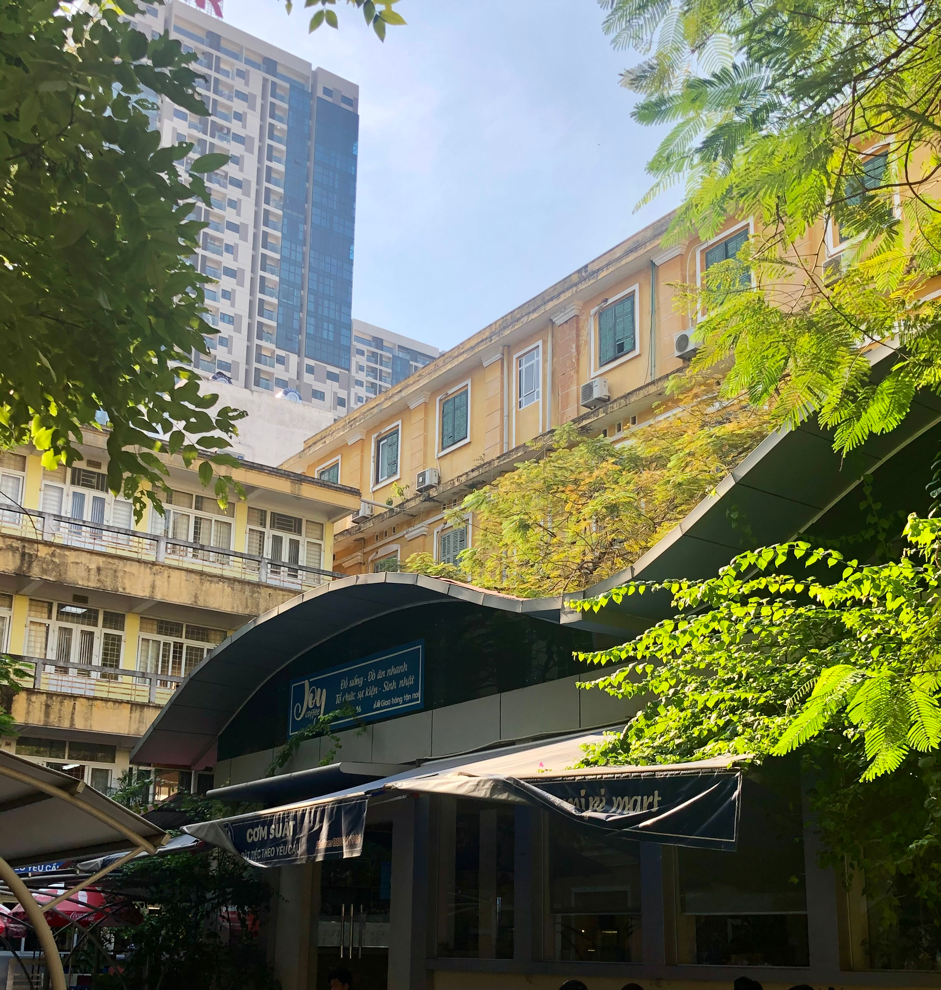For anyone thinking about a school, perhaps the familiar image will be teachers and lecture halls because clearly those are the most beautiful and most precious images. However, there is a familiar corner of many generations of students and lecturers that should not be forgotten - the school canteen. The canteen not only fills the emptiness of the stomach, warms the hands on a winter day with a cup of hot tea, but is also a place to connect many generations of teachers and students. For the author, the canteen contains traces of the years.
I entered the University of Social Sciences and Humanities on an autumn day more than 18 years ago. Since then, I have spent my youth here. At that time, building G where the main lecture halls of the school are now was being completed, building E was still in its infancy, and buildings A, B, C were separated by green spaces.

The Humanities in me that day was filled with the joy of a first-year university student!
I still remember the school canteen located in a corner of the current car garage. Calling it a canteen is probably too fancy, but back then, apart from iced tea, a few bottles of soft drinks, sunflower seeds, a little beef jerky, donuts, peanut candy, there weren’t many snacks. In front of the canteen door was a banyan tree that still had a part of its stump. The canteen back then wasn’t bright, there weren’t any shiny glass cabinets, and of course air conditioning was unthinkable. But back then, simplicity created nostalgia. When I was far away, I missed the frenetic guitar sounds of the group of students from the University of Natural Sciences, the raw singing of the student groups from Nhan Van who still chose the canteen as a gathering place, the image of cigarette smoke from my teachers who discussed work and rested before class. I missed the bright faces of my fellow students. To me, that small corner was lively, warm and friendly. I called the canteen back then the 1.0 generation canteen.
A few years later, perhaps in 2009, when building E was built (where the first, second and third floors served library activities), the canteen was located in a modest corner on the second floor of the building connecting building H and building E. The stairs to the canteen could be precarious, making women in dresses a bit hesitant. The tables and chairs were placed close together in a modest space, sometimes making it difficult for backpacks with books to squeeze through. However, that small corner was enough for students to date and lecturers to meet. For us staff, in a busy life with so many worries about teaching, topics, family matters, children, meeting each other for a few seconds, asking each other a few questions, waving to each other from two corners of the canteen was enough to warm our hearts. Ah, so he was still healthy, she was still working at the school, he was doing research, the teacher had just retired...
The 2.0 generation canteen has lemon instant noodles, rice rolls, potato spring rolls, and sweet sausages. These dishes have become so familiar that if you happen to eat them elsewhere, even if they are the same food, the same dish, and no matter how famous the restaurant is, you will still feel the lack. The flavor of habit, the sense of peace, the Vietnamese culture is lacking.
Now the school canteen is located between buildings B and C. The canteen is spacious, with a cafeteria and a small supermarket. I used to think that the glossy glass doors, the overly comfortable feeling of the air conditioner, and the free wifi had cut off the sweetness, warmth, simplicity and connection of the old canteen. I used to reminisce and miss the 1.0, 2.0 generation canteens of the past. But after an afternoon of chatting with the seniors and juniors of the innovation class under the bougainvillea shade, watching the students diligently study and discuss their lessons, listening to groups of students singing softly to the music of my canteen, things have changed. I also feel warmer knowing that my students no longer have to wander around every noon to find a far away restaurant or exhaustingly find a corner to rest. "Canteen food is now delicious and not expensive, teacher." With a stinging nose, I realized that I needed to change my way of thinking. The canteen is now modern and clean. And just think about it, I myself also find a cafe with good music, not too noisy and bustling, with the presence of friends whether studying or watching movies makes me feel that this life is full, colorful, and poetic. And in a society where social networks gradually make people forget about real relationships, this 3.0 canteen is still a place where real interactions take place every day. It's not winter yet for me to find the warm feeling of a hot cup of tea from the old days. But the days of social distancing due to the Covid-19 epidemic have made me realize how much I love the canteen. Those days, thinking about the image of the canteen with groups of students practicing flashmobs and cups of silver tea in hand makes me smile involuntarily. The sweet feeling seems to creep into my heart.
My 18 years at the University of Humanities were beautiful because of the teachers, friends, and students. Those 18 years were always associated with the images of lecture halls and library corners. And those 18 years would not have been complete without the canteen, whether it was 1.0, 2.0, or 3.0. ./.
Source:Faculty of International Studies